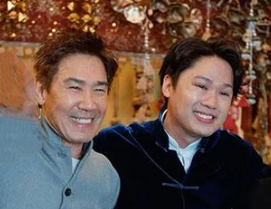Edmund Chen gave his son Chen Xi a well-worn Longines watch, but it was more than just a token gesture. It was incredibly successful in preserving decades’ worth of shared memories, personal experiences, and family tales. Chen Xi wears it every day as a very personal amulet, and the scratches and lines on its surface are not flaws but concrete recollections of times lived fully.

Popular personalities in Singapore’s entertainment industry, Edmund and his wife Xiang Yun, have centered their lives on principles that have significantly enhanced their family’s sense of closeness in addition to occupations that have brought them renown. That watch, which was given to the couple more than 20 years ago when they promoted Longines overseas, is now a symbol of that way of thinking. Even when Chen Yixin converted every hotel ballroom into a playground, Chen Xi, who was only a boy at the time, demonstrated his protective nature by taking care of his younger sister. Edmund then started to see how his son’s character would be marked by responsibility, resiliency, and affection—qualities that are highly flexible.
Bio Data and Personal Information
| Name | Chen Xi |
|---|---|
| Parents | Edmund Chen (father), Xiang Yun (mother) |
| Sibling | Chen Yixin (sister, actress) |
| Date of Birth | 1992 (approx., age 32) |
| Nationality | Singaporean |
| Education | Arts Management at King’s College London |
| Notable Connection | Son of veteran Singaporean actors Edmund Chen and Xiang Yun |
| Special Note | Wears a Longines watch passed down from his father as a legacy piece |
| Reference | 8Days.sg |
Edmund has called Chen Xi’s decision to wear the watch daily since leaving Singapore for King’s College London both heartwarming and unexpected. Once a useful accessory, the watch has evolved into a strikingly obvious reminder of his father’s counsel to live in the now and take advantage of opportunities that come and go. The relationship is quite similar to that of celebrities who pass down relics from one generation to the next—Prince William and Princess Diana’s sapphire ring, for example, or Hollywood families who preserve letters, clothes, or instruments as reminders of their common past.
Edmund acknowledges that he rarely wears accessories out of concern that he will misplace them, but this watch became a part of his adventure. He wore it across continents, during family dinners, and on stages. Its flaws convey a tale that is remarkably resilient and has far greater significance than any immaculate, unaltered item. In a time when he is physically separated from his family, it now symbolizes continuity for Chen Xi. Even though he is thousands of miles away, he feels connected to home every time he looks at the watch.
The way this novel depicts contemporary family dynamics is what makes it so inventive. Many families that are separated due to overseas education or employment depend on digital ties to stay connected. The Chens’ daily Telegram talks, which are full of insignificant updates like “I’m drinking kopi” or “I’m having noodles now,” are incredibly effective at closing the emotional divide caused by distance. This playful yet personal practice keeps people feeling connected.
Edmund acknowledges that he misses their coffee dates, not because of the caffeine but rather because they represented friendship and a way of life. Innumerable tales of parents negotiating the conflicting emotions of pride and absence as their kids mature bear a striking resemblance to this. However, he finds solace in the fact that Chen Xi shares his sentimental attachment to items and customs. The young guy even saved the first toy his father ever given him, and Edmund himself maintains a cupboard filled with sentimental items from his kids’ early years that are worthless in terms of money but invaluable in their significance.
A wider cultural change is also highlighted by Chen Xi’s arts management research. Not only is celebrity being passed on to the younger generation, but it is also being expanded into other fields. His decision is especially advantageous for Singapore’s creative sector since it highlights the need of managing and conserving culture rather than merely performing it. By expanding the idea of artistic contribution, it demonstrates how family legacies may change businesses.
